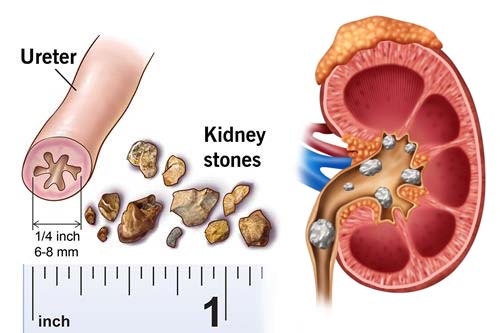
Kidney stones are hard deposits that form in the kidneys when there is an accumulation of certain substances in the urine. The most common types of kidney stones include calcium stones, uric acid stones, struvite stones, and cystine stones. The symptoms of kidney stones can vary but often include severe pain in the back or side, blood in the urine, frequent urination, and a strong urge to urinate.
If you suspect you have kidney stones, it’s important to seek medical attention for a proper diagnosis and appropriate treatment. A healthcare professional can conduct tests, such as imaging studies and urine analysis, to confirm the presence of kidney stones and determine their type and size. Treatment options for kidney stones depend on factors such as the size, location, and composition of the stones.
Here are some common treatments for kidney stones:
Stay hydrated: Drinking an adequate amount of water helps dilute the substances that can form kidney stones, reducing the risk of stone formation. Aim to drink at least 8 cups (64 ounces) of water per day, or more if recommended by your doctor. Increasing fluid intake, can help flush out smaller stones and prevent new ones from forming. It is typically recommended to drink enough fluids to produce about 2-2.5 liters of urine per day.
Pain management
Pain caused by kidney stones can be severe. Your doctor may prescribe pain medications to help manage the discomfort until the stones pass or are treated.
Dietary modifications
Adjusting your diet may help prevent the formation of certain types of kidney stones. Here are some tips:
Reduce sodium intake
High sodium levels can increase the amount of calcium in your urine, potentially leading to the formation of calcium-based stones. Limit your consumption of processed foods and use herbs and spices instead of salt for flavoring.
Moderate animal protein
Consuming excessive amounts of animal protein, such as red meat, poultry, and seafood, may increase the risk of kidney stones. Balance your protein sources and consider plant-based alternatives.
Limit oxalate-rich foods: Oxalate is a compound found in certain foods that can contribute to the formation of calcium oxalate stones. Examples include spinach, rhubarb, beets, nuts, and tea. Limiting these foods may help prevent stones in some cases.
Increase intake of citric acid
Citric acid may help prevent the formation of calcium-based stones. Citrus fruits like lemons and oranges are good sources of citric acid.
Maintain a healthy weight
Obesity and overweight can increase the risk of kidney stones. Aim to achieve and maintain a healthy weight through a balanced diet and regular exercise.
Herbal remedies:
Some herbs and natural remedies are believed to support kidney health and reduce the risk of kidney stones. However, scientific evidence on their effectiveness is limited. Some examples include:
Chanca piedra
This herb is traditionally used in Ayurvedic medicine and may help break down kidney stones and reduce their formation. However, more research is needed to confirm its effectiveness.
Nettle leaf
Nettle leaf tea is thought to have diuretic properties, potentially increasing urine flow and reducing the risk of stone formation.
Medications:
Depending on the type of kidney stones you have, your doctor may prescribe medications to help dissolve certain types of stones or to prevent the formation of new ones. These medications are typically used for specific cases and should be prescribed by a healthcare professional.
Extracorporeal Shock Wave Lithotripsy (ESWL):
This procedure uses sound waves to break large kidney stones into smaller pieces that can be passed more easily. The broken stones are then typically passed through the urinary tract.
Ureteroscopy:
In this procedure, a thin tube with a camera is inserted into the urinary tract to locate and remove or break up the kidney stones. It is often used for stones located in the ureters or kidneys.
Percutaneous Nephrolithotomy (PCNL):
PCNL is a surgical procedure used for large kidney stones. It involves making a small incision in the back to access the kidney and remove or break up the stones.
The appropriate treatment option will depend on several factors, so it’s crucial to consult with a healthcare professional who can evaluate your specific condition and recommend the most suitable course of action. They will consider factors such as the size, type, and location of the stones, as well as your overall health and medical history.
